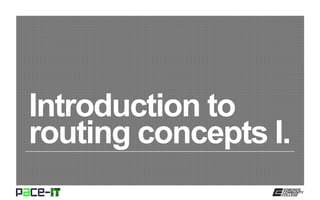
PACE-IT: Introduction_to Routing Concepts (part 1) - N10 006
- 2. Page 2 Instructor, PACE-IT Program – Edmonds Community College Areas of Expertise Industry Certifications PC Hardware Network Administration IT Project Management Network Design User Training IT Troubleshooting Qualifications Summary Education M.B.A., IT Management, Western Governor’s University B.S., IT Security, Western Governor’s University Entrepreneur, executive leader, and proven manger with 10+ years of experience turning complex issues into efficient and effective solutions. Strengths include developing and mentoring diverse workforces, improving processes, analyzing business needs and creating the solutions required— with a focus on technology.
- 3. Page 3 – The purpose of routing. – Basic routing concepts. PACE-IT.
- 4. Page 4 Introduction to routing concepts I.
- 5. Page 5 In a nutshell, the purpose of routing is to connect different networks together to allow them to communicate and pass data traffic. Most often, routing protocols are how networks determine where to send network traffic (the routes they will take). They build maps (actually routing tables) that they use for directing network traffic. Routing is what makes this interconnected world function as well as it does. Networking would be pure chaos without it. Introduction to routing.
- 6. Page 6 Introduction to routing concepts I.
- 7. Page 7 – Static routing. » Uses administrator defined routes. » Each router must contain the route. • A static route from A to B requires that B has a static route to A. » Easy to set up (in a small network). • Not so easy to maintain. » Routes only change when the administrator changes them. – Dynamic routing. » Routers use protocols in order to determine the best route between two networks. » Administrator determines which protocols will be in use. » The routers must all use the same protocols. • An exception is when route redistribution has been implemented. » Routing protocols can be stacked within a router. » Is very fluid and dynamic in nature and is what makes possible today’s interconnected world. Introduction to routing concepts.
- 8. Page 8 – The default route. » The direction that a router will send network traffic when there is no known route in the routing table. • It is assigned by an administrator. • It is usually a designated interface on the router or it is the designated next hop interface. – The routing table. » A list of known routes to all known networks from the router’s perspective. • It is established by an administrator when static routing is used. • It is dynamically built by routing protocols when dynamic routing is employed. » Each routing protocol maintains a routing table. • Different routing protocols may have different routes to the same network. Introduction to routing concepts.
- 9. Page 9 – Loopback interface. » An administratively configured logical number assigned to a router to ease administrative functions or routing processes. • Often, the loopback interface is assigned in an IPv4 address format. • Many routing protocols have been designed to take the loopback interface into account when performing administrative functions. » The interface may be completely logical, or a physical interface may be assigned to be the loopback interface. – Routing loops. » A possible problem that can be created if interconnected routers have a breakdown in their routing algorithms. • When a routing loop occurs, the network keeps looping through the routers until some system or mechanism breaks the cycle. • They can create network congestion or even bring down a network. » Routing protocols use multiple methods to prevent loops from occurring. • The time to live (TTL) field is also utilized to stop routing loops after they have occurred. Introduction to routing concepts.
- 10. Page 10 Introduction to routing concepts I. The purpose of routing is to connect different networks together logically for communications purposes and to allow for network data traffic to reach remote networks. Most often, routing protocols are used to build dynamic routes between networks. Topic The purpose of routing. Summary Static routing involves administratively configured routes between networks—the administrator must manually make any changes. Dynamic routing involves protocol configured routes between networks—the protocols determine when and how to make routing changes. A default route is the interface or next hop that a router sends a network packet to when no known route exists. The routing table is the administratively configured or protocol configured table of routes to all known networks. A loopback interface is a logically assigned interface used to ease the administrative management of a router. A routing loop is a possible problem between interconnected routers where network traffic keeps circling until some system or mechanism breaks the cycle. Basic routing concepts.
- 12. This workforce solution was 100 percent funded by a $3 million grant awarded by the U.S. Department of Labor's Employment and Training Administration. The solution was created by the grantee and does not necessarily reflect the official position of the U.S. Department of Labor. The Department of Labor makes no guarantees, warranties, or assurances of any kind, express or implied, with respect to such information, including any information on linked sites and including, but not limited to, accuracy of the information or its completeness, timeliness, usefulness, adequacy, continued availability or ownership. Funded by the Department of Labor, Employment and Training Administration, Grant #TC-23745-12-60-A-53. PACE-IT is an equal opportunity employer/program and auxiliary aids and services are available upon request to individuals with disabilities. For those that are hearing impaired, a video phone is available at the Services for Students with Disabilities (SSD) office in Mountlake Terrace Hall 159. Check www.edcc.edu/ssd for office hours. Call 425.354.3113 on a video phone for more information about the PACE-IT program. For any additional special accommodations needed, call the SSD office at 425.640.1814. Edmonds Community College does not discriminate on the basis of race; color; religion; national origin; sex; disability; sexual orientation; age; citizenship, marital, or veteran status; or genetic information in its programs and activities.
